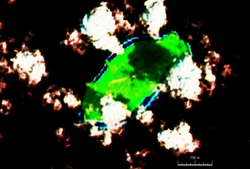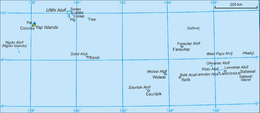Fais Island

NASA picture of Fais Island
|
|
| Geography | |
|---|---|
| Location | North Pacific |
| Coordinates | 9°45′37″N 140°31′15″E / 9.76028°N 140.52083°E |
| Archipelago | Caroline |
| Total islands | 1 |
| Area | 2.6 km2 (1.0 sq mi) |
| Highest elevation | 18 m (59 ft) |
| Administration | |
| Demographics | |
| Population | 215 (2000) |
| Ethnic groups | Micronesian |
Fais Island is a raised coral island in the eastern Caroline Islands in the Pacific Ocean, and forms a legislative district in Yap State in the Federated States of Micronesia. Fais Island is located approximately 87 kilometres (54 mi) east of Ulithi and 251 kilometres (156 mi) northeast of Yap and is the closest land to Challenger Deep, about 180 miles away.
The population of Fais Island was 215 in 2000.
Fais Island is an oblong, oval-shaped raised coralline mass with a maximum elevation of 18 metres (59 ft), surrounded by a narrow lagoon and fringing reef except for its northeast and southwest extremities. It has a total land area of 2.6 square kilometres (1.0 sq mi).
Friedrich Ratzel in The History of Mankind related in 1896 that the Polynesian legend of the fishing up of the land from the depths of the sea took the following form in Yap: Motigtig went out fishing with his two elder brothers Morangrang and Motal. First, he hooked up crops of all sorts, and taro; then the island of Fais. His hook was stolen and kept by the chief in gachpar in order to control the people; and since, if it were destroyed, Fais also would disappear, the inhabitants of that island were in constant subjection to the menaces of the Yap chiefs in Gagil.
First recorded sighting of Fais Island was by the Spanish expedition of Ruy López de Villalobos on 23 January 1543. Quite surprisingly for the Spaniards, the local people came out in canoes making the sign of the cross and saying "Buenos días, matelotes!" in perfect sixteenth century Spanish ("Good day, sailors!"), this being an evidence that one of the previous Spanish expeditions had been in the area. Fais was therefore charted as Matelotes. Having known about this story, António Galvão governor of Ternate at the time, in his Tratado dos Descubrimientos of 1563 says that this was because he had sent one Francisco de Castro as commander of a ship on a proselytizing mission to the islands discovered in the area of Fais by the Portuguese Diego da Rocha (Ulithi in 1526). However, while this could be a natural explanation of the incident, it doesn't explain why, according to Villalobos' records the local people greeted them in "perfect" Spanish and not in Portuguese. The original account of this story is included in the report that the Augustinian Fray Jerónimo de Santisteban, travelling with the Villalobos' expedition, wrote for the Viceroy of New Spain, while in Kochi during the voyage home.
...
Wikipedia

